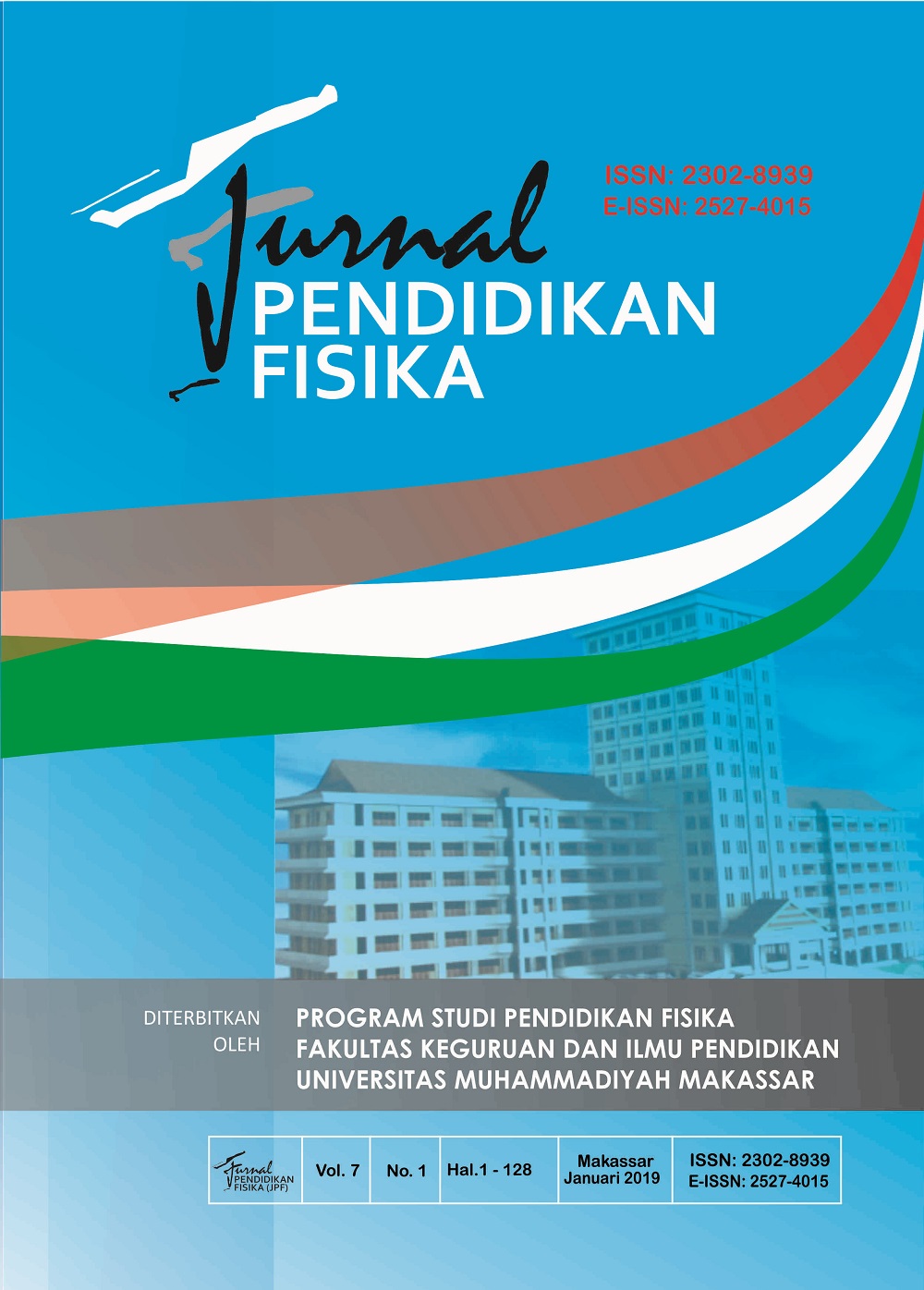Enhancing Students' Critical Thinking Skills through Inquiry Learning Model at SMA Negeri 9 Makassar
DOI:
https://doi.org/10.26618/jpf.v7i1.1738Abstract
The research included Classroom Action Research (CAR) with the aim of knowing the improvement of critical thinking skills through the inquiry learning model. Classroom Action Research was carried out at the eleventh MIA 5 grade of sixteen state senior high school of Makassar. The research consisted of two cycles. The first cycle consists of two actions and the second cycle also consists of two actions. The procedure carried out in each cycle consists of planning, implementation, observation, and reflection. For getting the data used the observation sheet and the results of test scores in each cycle. The data analysis technique used descriptive analysis and qualitative analysis. The results of the study showed that it increased through the use of the inquiry learning model. The students critical thinking skills in the first cycle increased even though the increase was not too significant than before the implementation of the inquiry learning model. In cycle one , the students were divided into 5 groups and learning using the free inquiry model then proceed to cycle two critical thinking skills increased from cycle one. In cycle two the number of groups was enlarged into 8 groups and in the learning process students were guided to find so Critical thinking of trained students and can be improved.
Keywords: Critical Thinking, Inquiry Learning, Students
Penelitian ini termasuk Penelitian Tindakan Kelas dengan tujuan untuk mengetahui peningkatan keterampilan berpikir kritis melalui model pembelajaran inquiry. Penelitian Tindakan Kelas dilaksanakan di SMA Negeri 16 Makassar kelas XI MIA 5. Penelitian ini terdiri dari dua siklus. Siklus pertama terdiri dari dua tindakan dan siklus kedua juga terdiri dari dua tindakan. Prosedur yang dilaksanakan pada setiap siklus terdiri dari perencanaan, pelaksanaan, observasi, dan refleksi. Untuk mendapatkan data digunakan lembar observasi dan hasil nilai tes pada setiap siklus. Teknik analisis data yang digunakan adalah analisis deskriptif dan analisis kualitatif. Hasil penelitian menunjukkan bahwa meningkat melalui penggunaan model pembelajaran inquiry. Keterampilan berpikir kritis peserta didik pada siklus I meningkat meskipun peningkatannya tidak terlalu signifikan dari sebelum diterapkannya model pembelajaran inquiry. Pada Siklus I peserta didik peserta didik dibagi menjadi 5 kelompok dan pembelajaran menggunakan model inquiry bebas kemudian dilanjutkan ke siklus II keterampilan berpikir kritis meningkat dari siklus I. Pada siklus II jumlah kelompok diperbesar menjadi 8 kelompok dan pada proses pembelajaran peserta didik dibimbing untuk menemukan sehingga keterampilan berpikir kritis peserta didik terlatih dan dapat meningkat.
Kata kunci: Berpikir Kritis, Pembelajaran Inkuiry, Peserta Didik
References
Arikunto. 2007. Prosedur Penelitian Suatu Pendekatan Praktik. Jakarta: Rineka Aksara
Azar, A. 2010. The Effect of Critical Thinking Dispositions on Students Achievement in Selection and Placement Exam for University in
Turkey. Journal of Turkish Science Education, 61-73.
Hamalik, Oemar. 2009. Proses Belajar Mengajar. Jakarta: Bumi Aksara.
Hanafiah, Nanang & Cucu, Suhana. 2010. Konsep Strategi Pembelajaran. Refika Aditama. Bandung.
Hosnan, M. 2014. Pendekatan Saintifik dan Kontekstual dalam Pembelajaran Abad 21. Jakarta: Ghalia Indonesia.
Ismienar, S, dkk. 2009. Thinking. Malang: FIP Universitas Negeri Malang.
Komalasari. 2010. Pembelajaran Kontekstual Konsep dan Aplikasi. Bandung: Rifika Aditama.
Pusat Bahasa. 2014. Kamus Besar Bahasa Indonesia Edisi Keempat. Jakarta: Kompas Gramedia.
Ricketts, J. C. 2004. The Relationship between Critical Thinking Dispositions and Critical Thinking Skills of. Journal of Southern Agricultural Education Research, 21-33.
Saragih, S. 2007. Mengembangkan Kemampuan Logis dan Komunikasi Matematik Siswa Sekolah Menengah Pertama Melalui Pendekatan Matematika Realistik. Bandung: PPs UPI.
Sardiman. 2010. Interaksi dan Motivasi Belajar Mengajar. Jakarta: Rajawali Pers.
Trianto. 2009. Mendesain Metode pembelajaran Inovatif-Progres. Jakarta: Kencana Prenada Media Group.
Downloads
Published
Issue
Section
License
Copyright:
Authors who publish with this journal agree to the following terms:
1. Authors retain copyright and grant the journal right of first publication with the work simultaneously licensed under a Creative Commons Attribution-ShareAlike 4.0 International License that allows others to share the work with an acknowledgement of the work's authorship and initial publication in this journal.
2. Authors are able to enter into separate, additional contractual arrangements for the non-exclusive distribution of the journal's published version of the work (e.g., post it to an institutional repository or publish it in a book), with an acknowledgement of its initial publication in this journal.
3. Authors are permitted and encouraged to post their work online (e.g., in institutional repositories or on their website) prior to and during the submission process, as it can lead to productive exchanges, as well as earlier and greater citation of published work.
Licence:
Authors are free to:
1. Share: Copy and redistribute the material in any medium or format
2. Adapt: Remix, transform, and build upon the material for any purpose, even commercially.
The licensor cannot revoke these freedoms as long as the authors follow the license terms, which include the following:
1. Attribution: You must give appropriate credit, provide a link to the license, and indicate if changes were made. You may do so in any reasonable manner, but not in any way that suggests the licensor endorses you or your use.
2. ShareAlike: If you remix, transform, or build upon the material, you must distribute your contributions under the same license as the original.
3. No additional restrictions: You may not apply legal terms or technological measures that legally restrict others from doing anything the license permits.
Jurnal Pendidikan Fisika is licensed under a Creative Commons Attribution-ShareAlike 4.0 International License.

